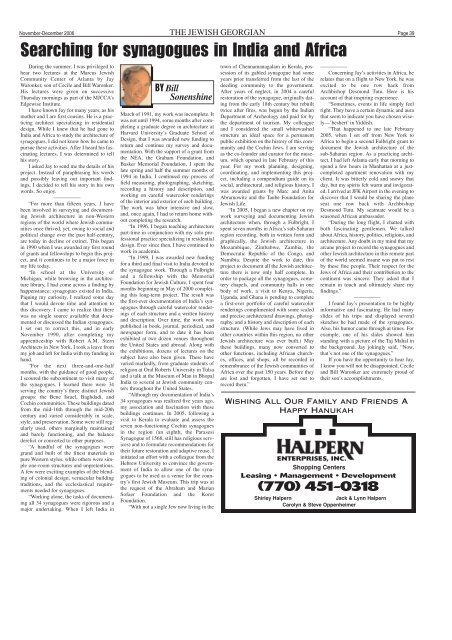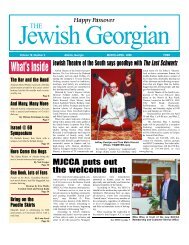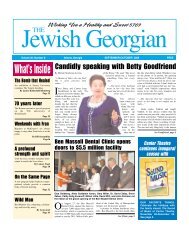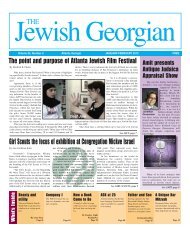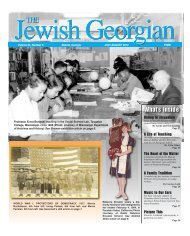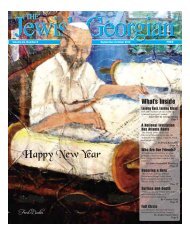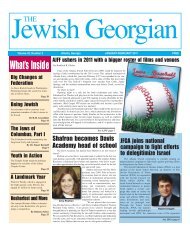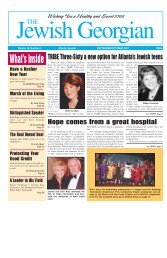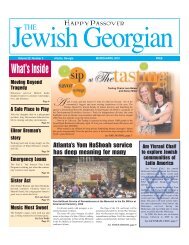Balfoura Friend Levine - The Jewish Georgian
Balfoura Friend Levine - The Jewish Georgian
Balfoura Friend Levine - The Jewish Georgian
You also want an ePaper? Increase the reach of your titles
YUMPU automatically turns print PDFs into web optimized ePapers that Google loves.
November-December 2006 THE JEWISH GEORGIAN Page 39<br />
Searching for synagogues in India and Africa<br />
During the summer, I was privileged to<br />
hear two lectures at the Marcus <strong>Jewish</strong><br />
Community Center of Atlanta by Jay<br />
Waronker, son of Cecile and Bill Waronker.<br />
His lectures were given on successive<br />
Thursday mornings as part of the MJCCA’s<br />
Edgewise Institute.<br />
I have known Jay for many years, as his<br />
mother and I are first cousins. He is a practicing<br />
architect specializing in residential<br />
design. While I knew that he had gone to<br />
India and Africa to study the architecture of<br />
synagogues, I did not know how he came to<br />
pursue these activities. After I heard his fascinating<br />
lectures, I was determined to tell<br />
his story.<br />
I asked Jay to send me the details of his<br />
project. Instead of paraphrasing his words<br />
and possibly leaving out important findings,<br />
I decided to tell his story in his own<br />
words. So enjoy.<br />
—————<br />
“For more than fifteen years, I have<br />
been involved in surveying and documenting<br />
<strong>Jewish</strong> architecture in non-Western<br />
regions of the world where <strong>Jewish</strong> communities<br />
once thrived, yet, owing to social and<br />
political change over the past half-century,<br />
are today in decline or extinct. This began<br />
in 1990 when I was awarded my first round<br />
of grants and fellowships to begin this project,<br />
and it continues to be a major force in<br />
my life today.<br />
“In school at the University of<br />
Michigan, while browsing in the architecture<br />
library, I had come across a finding by<br />
happenstance: synagogues existed in India.<br />
Piquing my curiosity, I realized some day<br />
that I would devote time and attention to<br />
this discovery. I came to realize that there<br />
was no single source available that documented<br />
or discussed the Indian synagogues.<br />
I set out to correct this, and in early<br />
November 1990, after completing my<br />
apprenticeship with Robert A.M. Stern<br />
Architects in New York, I took a leave from<br />
my job and left for India with my funding in<br />
hand.<br />
“For the next three-and-one-half<br />
months, with the guidance of good people,<br />
I scoured the subcontinent to visit many of<br />
the synagogues. I learned there were 34<br />
serving the country’s three distinct <strong>Jewish</strong><br />
groups: the Bene Israel, Baghdadi, and<br />
Cochin communities. <strong>The</strong>se buildings dated<br />
from the mid-16th through the mid-20th<br />
century and varied considerably in scale,<br />
style, and preservation. Some were still regularly<br />
used, others marginally maintained<br />
and barely functioning, and the balance<br />
derelict or converted to other purposes.<br />
“A handful of the synagogues were<br />
grand and built of the finest materials in<br />
pure Western styles, while others were simple<br />
one-room structures and unpretentious.<br />
A few were exciting examples of the blending<br />
of colonial design, vernacular building<br />
traditions, and the ecclesiastical requirements<br />
needed for synagogues.<br />
“Working alone, the tasks of documenting<br />
all 34 synagogues were rigorous and a<br />
major undertaking. When I left India in<br />
BY<br />
Bill<br />
Sonenshine<br />
March of 1991, my work was incomplete. It<br />
was not until 1994, some months after completing<br />
a graduate degree in architecture at<br />
Harvard University’s Graduate School of<br />
Design, that I was awarded new funding to<br />
return and continue my survey and documentation.<br />
With the support of a grant from<br />
the NEA, the Graham Foundation, and<br />
Basker Memorial Foundation, I spent the<br />
late spring and half the summer months of<br />
1994 in India. I continued my process of<br />
field measuring, photographing, sketching,<br />
recording a history and description, and<br />
working on careful watercolor renderings<br />
of the interior and exterior of each building.<br />
<strong>The</strong> work was labor intensive and slow,<br />
and, once again, I had to return home without<br />
completing the research.<br />
“In 1996, I began teaching architecture<br />
part-time in conjunction with my solo professional<br />
practice specializing in residential<br />
design. Ever since then, I have continued to<br />
work in academia.<br />
“In 1999, I was awarded new funding<br />
for a third and final visit to India devoted to<br />
the synagogue work. Through a Fulbright<br />
and a fellowship with the Memorial<br />
Foundation for <strong>Jewish</strong> Culture, I spent four<br />
months beginning in May of 2000 completing<br />
this long-term project. <strong>The</strong> result was<br />
the first-ever documentation of India’s synagogues<br />
through careful watercolor renderings<br />
of each structure and a written history<br />
and description. Over time, the work was<br />
published in book, journal, periodical, and<br />
newspaper form, and to date it has been<br />
exhibited at two dozen venues throughout<br />
the United States and abroad. Along with<br />
the exhibitions, dozens of lectures on the<br />
subject have also been given. <strong>The</strong>se have<br />
varied markedly, from graduate students of<br />
religion at Oral Roberts University in Tulsa<br />
and a talk at the Museum of Man in Bhopal<br />
India to several at <strong>Jewish</strong> community centers<br />
throughout the United States.<br />
“Although my documentation of India’s<br />
34 synagogues was realized five years ago,<br />
my association and fascination with these<br />
buildings continues. In 2005, following a<br />
visit to Kerala to evaluate and assess the<br />
seven non-functioning Cochin synagogues<br />
in the region (an eighth, the Parasesi<br />
Synagogue of 1568, still has religious services)<br />
and to formulate recommendations for<br />
their future restoration and adaptive reuse, I<br />
initiated an effort with a colleague from the<br />
Hebrew University to convince the government<br />
of India to allow one of the synagogues<br />
to be used as a venue for the country’s<br />
first <strong>Jewish</strong> Museum. This trip was at<br />
the request of the Abraham and Marian<br />
Sofaer Foundation and the Koret<br />
Foundation.<br />
“With not a single Jew now living in the<br />
town of Chennamanagalam in Kerala, possession<br />
of its gabled synagogue had some<br />
years prior transferred from the last of the<br />
deeding community to the government.<br />
After years of neglect, in 2004 a careful<br />
restoration of the synagogue, originally dating<br />
from the early 18th century but rebuilt<br />
twice after fires, was begun by the Indian<br />
Department of Archeology and paid for by<br />
the department of tourism. My colleague<br />
and I considered the small whitewashed<br />
structure an ideal space for a permanent<br />
public exhibition on the history of this community<br />
and the Cochin Jews. I am serving<br />
as the co-founder and curator for the museum,<br />
which opened in late February of this<br />
year. For my work planning, designing,<br />
coordinating, and implementing this project,<br />
including a compendium guide on its<br />
social, architectural, and religious history, I<br />
was awarded grants by Marc and Anita<br />
Abramowitz and the Taube Foundation for<br />
<strong>Jewish</strong> Life.<br />
“In 2005, I began a new chapter on my<br />
work surveying and documenting <strong>Jewish</strong><br />
architecture when, through a Fulbright, I<br />
spent seven months in Africa’s sub-Saharan<br />
region recording, both in written form and<br />
graphically, the <strong>Jewish</strong> architecture in<br />
Mozambique, Zimbabwe, Zambia, the<br />
Democratic Republic of the Congo, and<br />
Namibia. Despite the work to date, this<br />
project to document all the <strong>Jewish</strong> architecture<br />
there is now only half complete. In<br />
order to package all the synagogues, cemetery<br />
chapels, and community halls in one<br />
body of work, a visit to Kenya, Nigeria,<br />
Uganda, and Ghana is pending to complete<br />
a first-ever portfolio of careful watercolor<br />
renderings complimented with some scaled<br />
and precise architectural drawings, photography,<br />
and a history and description of each<br />
structure. (While Jews may have lived in<br />
other countries within this region, no other<br />
<strong>Jewish</strong> architecture was ever built.) May<br />
these buildings, many now converted to<br />
other functions, including African churches,<br />
offices, and shops, all be recorded in<br />
remembrance of the <strong>Jewish</strong> communities of<br />
Africa over the past 150 years. Before they<br />
are lost and forgotten, I have set out to<br />
record them.”<br />
—————<br />
Concerning Jay’s activities in Africa, he<br />
relates that on a flight to New York, he was<br />
excited to be one row back from<br />
Archbishop Desmond Tutu. Here is his<br />
account of that inspiring experience.<br />
“Sometimes, events in life simply feel<br />
right. <strong>The</strong>y have a certain dynamic and aura<br />
that seem to indicate you have chosen wisely—’beshert’<br />
in Yiddish.<br />
“That happened to me late February<br />
2005, when I set off from New York to<br />
Africa to begin a second Fulbright grant to<br />
document the <strong>Jewish</strong> architecture of the<br />
sub-Saharan region. As a practicing architect,<br />
I had left Atlanta early that morning to<br />
spend a few hours in Manhattan at a justcompleted<br />
apartment renovation with my<br />
client. It was bitterly cold and snowy that<br />
day, but my spirits felt warm and invigorated.<br />
I arrived at JFK Airport in the evening to<br />
discover that I would be sharing the plane<br />
seat one row back with Archbishop<br />
Desmond Tutu. My seatmate would be a<br />
seasoned African ambassador.<br />
“During the long flight, I chatted with<br />
both fascinating gentlemen. We talked<br />
about Africa, history, politics, religions, and<br />
architecture. Any doubt in my mind that my<br />
arcane project to record the synagogues and<br />
other <strong>Jewish</strong> architecture in this remote part<br />
of the world seemed insane was put to rest<br />
by these fine people. <strong>The</strong>ir respect for the<br />
Jews of Africa and their contribution to the<br />
continent was sincere. <strong>The</strong>y asked that I<br />
remain in touch and ultimately share my<br />
findings.”<br />
—————<br />
I found Jay’s presentation to be highly<br />
informative and fascinating. He had many<br />
slides of his trips and displayed several<br />
sketches he had made of the synagogues.<br />
Also, his humor came through at times. For<br />
example, one of his slides showed him<br />
standing with a picture of the Taj Mahal in<br />
the background. Jay jokingly said, “Now,<br />
that’s not one of the synagogues.”<br />
If you have the opportunity to hear Jay,<br />
I know you will not be disappointed. Cecile<br />
and Bill Waronker are extremely proud of<br />
their son’s accomplishments.<br />
Wishing All Our Family and <strong>Friend</strong>s A<br />
Happy Hanukah<br />
ENTERPRISES, INC.<br />
Shopping Centers<br />
Leasing • Management • Development<br />
(770) 451-0318<br />
Shirley Halpern Jack & Lynn Halpern<br />
Carolyn & Steve Oppenheimer


